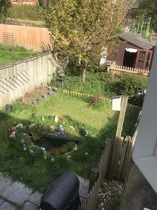A weed is simply a plant that grows somewhere you don't want it to grow
?
Gransnet forums
Gardening
Wildlife Garden and Weeds
(23 Posts)What is your definition of a weed though ... a dandelion is a fabulous pantry for our bees as are so many so called weeds
What is a weed? a flower or plant that is cheeky and comes up where you haven’t asked it to that’s really all
Read up on wild flowers and ‘weeds’ they all have a purpose remember the dock leaves, as kids our mums would rub on our nettle rash, thats the reason they often grow close by each other
I think nature has tried hard to give all that grows a purpose it’s us that prefer to spend money on buying ‘special’ plants and manicure our gardens
I m trying to learn more about wild flowers (ie weeds)
When we built our house the level bit of land which we wanted to turn into a wildflower meadow had been an oil seed rape field. We had a large part rotavated but that just disturbs the dormant seeds and they will come up. And they did and swamped the seeds that we had sown.
We tried other methods but found that the best thing was to cut it in the autumn and leave it. Grass will continue to grow throughout the winter. The annual cutting will eventually result in the thug plants (thistles, dock etc ) disappearing.
September/October is a good time to cut because the flowers will have set seed by then. Cowslips seed doesn't ripen until the summer. If you cut in spring you run the risk of cutting
off plants that are just poking through.
You should rake off the mowings because you don't want them to rot down and enrich the soil. Wild flowers are better on impoverished soil.
When you are walking about your flower patch, take a pair of scissors and cut off the seed heads of those weeds that you don't want.
If you live near countryside, and the soil is similar to yours, take a walk and see what plants are growing and you can then by those seeds. It might be a good idea to sew the seeds into seed trays and then pot them up into small pots so that you can transplant them.
Our meadow is looking particularly good at the moment. It's very green and right now we have orchids coming through and also Spiked Star of Bethlehem. Tasseled hyacinths are just going over and cowslips and violets are long gone. Later on we will have campion, some very tiny pinks, candytuft and wild sage.
The downside of not cutting until the autumn is that in late summer, especially if its been dry, the meadow doesn't look too good. But once it's been cut we start to notice other things.
The last time I did a count we had nearly 100 varieties of wild flower throughout the year and the plants from seed that we had sown have all gone.
Maybe some research on wild flowers and plants that attract insects might help you.
The Wild Life Trust and RHS websites might be a good place to start.
A weed is simply a plant that grows somewhere you don't want it to grow. Many 'weeds' are beautiful and attract wildlife. Some butterflies rely on nettles so don't get rid of all of them. If you want to make sure they don't take over again then plant some in a large pot and bury it in the ground. That will stop the roots spreading. Don't underestimate dandelions and daisies. Simple flowers are often the easiest for bees and butterflies to access.
Look for self seeding annuals and perennials. then you will have a patch that becomes self propagating.
How about sowing the seeds in diagonal lines across the patch. Make a drill with a stick or something similar, sow the seed in the drill and then fill. Mark the drill with sand so that you know where the wildflower seeds are supposed to come up. Anything outside the lines will probably be weeds, so you can take them out. Once the wildflowers have grown, the lines will be less defined and will look natural. Or you could try curvy lines using the same method. I've used this technique several times in my borders and it has worked, more or less. If the odd weed creeps it, it is usually obvious as it will be different from the majority of seedlings.
My local council have sowed verges with wild flowers and they are just left to grow weeds and all it looks spectacular in the Summer.
Many so called weeds are fabulous for insects, night or day.
You need a “trained eye”, Chestnut. It comes with experience. Ask someone who does gardening to help you identify the weeds. You will learn but it takes time.
But the weeds will be the ones I didn't plant and they will not attract night insects!
A weed is a wild flower they are the same ?
If it is an area designated for wildlife I would sow your seeds but leave the weeds. Bugs are happy in an overgrown patch.
I still don't understand how to identify the weeds amongst the wild flowers when they start growing.
I can't do that as I would end up with docks and brambles and nothing else
Just spotted some more details on the seeds. The bat attractor pack is a specially selected mix of night-scented wildflower seeds to attract insects for bats containing: bladder campion, red campion, night catch-fly, corn chamomile, cornflower, cowslip, evening primrose, field poppy, fleabane, foxglove, great mullein, corn marigold, soapwort, vipers bugloss, yarrow.
It also gives sowing guidelines: Sow March to May or September to October, outdoors directly onto soil where they are to flower, once the soil has warmed. For best results choose a poor, infertile soil in full sun and do not add fertiliser.
Maybe I should have looked this up first! ?
The seeds are actually bat-friendly as we have a bat. They are native wild flowers. It says: The pack contains a special mix of wildflower seeds for night-scented plants, which attract insects to the flowers and are in turn are food for bats. So maybe they attract more night flying insects than day ones. There are different mixes for birds, bees and butterflies apparently.
Chestnut
Thanks. It's only a small area so hopefully not too big a job. And we have a gardener starting who will be doing it. He will have to weed the area now as it has a lot, but I was hoping he could then plant the seeds. So we will have to wait until next Spring to plant them?
not necessarily, but once sown, the ground will need to be kept well watered. Can I also suggest that you don't buy the mixtures or "bee bombs" but look at your soil type, aspect and light levels and then do some online research about what will grow?
Thanks. It's only a small area so hopefully not too big a job. And we have a gardener starting who will be doing it. He will have to weed the area now as it has a lot, but I was hoping he could then plant the seeds. So we will have to wait until next Spring to plant them?
It depends what you want. Nettles and dandelions are a very important food source for bees so consider not removing entirely what we think of as weeds. Is there space for both in separate areas of the garden? Birds love dandelion seeds too.
Check the seed packs of bee-friendly plants to see which can be started in pots and moved to their flowering places later. Not all plants like being transplanted.
Many of the seeds included in bee packs are are arguably "weeds" any way - knapweed (centaurea) for example and borage which also grows wild.
Also check the seed pack or web source to familarise yourself with what particular seedlings look like.
Agree with Kali wait, weed the area by hand, section by section, don’t rotovate the weeds, you’ll just get more. It is hard work.
Then you will have to leave it till the autumn, and mecanically remove the weeds, rotovate, rotovate again in Spring and plant flower seeds. Then pull weeds as and when they come up. A big job.
I'm not much of a gardening expert. There is a small area in our communal garden which is full of weeds, and I'd like to plant an assorted pack of bee friendly flowers. Obviously the weeds have to be cleared first. My question is: when things start growing how will we know what are weeds and what are the flowers from the pack? Do we just leave it alone? I don't want all the weeds coming up amongst the flowers or they will prevent them growing properly.
Join the conversation
Registering is free, easy, and means you can join the discussion, watch threads and lots more.
Register now »Already registered? Log in with:
Gransnet »

